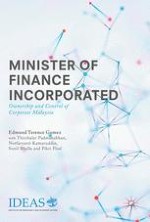Abstract
This chapter deals with GLIC ownership structures, looking particularly at the companies in which they have a majority interest among the top 100 enterprises quoted on the domestic stock exchange, the Bursa Malaysia. These GLICs have majority ownership of 35 companies publicly listed among the top 100 enterprises in terms of market capitalization. In this chapter, the development of these 35 GLCs is traced, with specific focus on how the GLICs have come to obtain ownership of these firms. The ownership patterns of these companies are assessed from a sectoral perspective, that is, utilities, plantations, property development and construction, oil and gas, banking, media, services and healthcare. The chapter pays particular attention to how the GLICs have come to acquire a significant presence in four core sectors: plantations, banking and finance, property development and construction, and media.
This chapter then studies how these seven GLICs function as business groups. Although all the GLICs can be classified as business groups, they fundamentally differ from each other in terms of the way they function, the business ownership methods they employ and how they control the companies in which they have an equity interest. This chapter identifies how the ownership patterns of the GLCs by the seven GLICs differ. While some GLICs have majority equity ownership of GLCs, others merely hold a minority interest in a large number of quoted companies. Block shareholdings are common, where two or more GLICs have an equity interest in GLCs. In most of these block shareholding situations, however, one GLIC has majority ownership of the GLC. Also noted here is the use of obscure private companies by the GLICs to function as shareholders of some important GLCs as a means to shield the extent of government ownership of a particular enterprise—a pattern most obvious in the media sector. What these ownership patterns indicate is that one company, MoF Inc., has overwhelming influence over the other six GLICs, with the possible exception of LTAT, long led by a corporate figure closely associated with Prime Minister Najib Razak. Although the focus of this study is GLICs associated with the federal government, the presence of state government investment arms such as Johor Corporation or State Financial Secretary Sarawak is noted and discussed.
